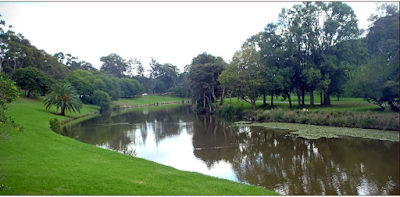The
indigenous history of Eastwood includes the period when the Wallumedegal people
lived in the territory bounded by the Lane Cove and Parramatta rivers. Part of
the Dharug group, their country was called Wallumetta. [1]
The 1820s saw
the building of Brush Farm House by Gregory Blaxland, following his purchase of
the Brush Farm Estate in 1807. Located in what is now Eastwood, the house
survives, representing a nationally important site where some of the colony's
initial land grants were made.[2]
The suburb
Eastwood gets its name from the Eastwood Estate and house, the original owner
of which was William Rutledge who built a single storey house on the hill to
the east of Brush Farm in 1840.[3] Edward Terry, later the first mayor of Ryde,
purchased the estate around 1871 and after his death, it was subdivided to
emerge as Eastwood Village.
In 1868, the
tart green Granny Smith apple was developed in Eastwood by an English-born
orchardist, Maria Ann Smith. She apparently found a seedling growing in her
compost heap after throwing out the remains of some Tasmanian crab
apples.[4]
In the 1890s,
during a severe economic depression, Harry Curzon-Smith built the stately
Curzon Hall which is now located just beyond the borders of Eastwood, in
Marsfield. Now considered one of Australia’s finest reception centres, it was
built from local sandstone quarried from what is now a pond in the grounds of
Macquarie University.[5]
Marsfield
Municipality seceded from Ryde in 1894 and was renamed Eastwood in 1907. It was
never an affluent council because of the small number of rate payers within its
boundaries and it re-joined Ryde in 1948.[6]
Multiculturalism
began taking root in the Eastwood by the 1920s when many of the orchards and
market gardens in the region were beginning to be owned by Italians – who, with
the Greeks, were the first outsiders to put down roots in the district.[7] In
the Eastwood Municipality the first Chinese market gardens appear in the Sands
Directory by 1921; by the end of that decade there were 14 such gardens
listed.[8]
The end of
the Second World War saw an influx of returned servicemen and post-war migrants
that led to demand for homes and selling off of much vacant land for
residential development. Commercially the suburb expanded as well and by the
1960s, Eastwood became the favoured shopping venue between Strathfield and
Hornsby.[9]
The 1990s saw
the arrival of many people from Asia, particularly Hong Kong, China, Korea and
south-east Asia.[10] Over two decades later, Eastwood is now a multicultural
centre, with - according to the 2011 census – just over 30% of residents
claiming Chinese ancestry.[11]
Notable
personalities
Some notables
connected with Eastwood include:
•Geoffrey
Robertson, QC who attended Eastwood Public School from 1954-1959[12]
•Maria Ann
Smith, the ‘inventor’ of the Granny Smith apple, lived on a farm between the
present North Road and Abuklea Road, Eastwood.[13]
Notable
buildings
•Brush Farm
Built by one
of the European explorers of the Blue Mountains Gregory Blaxland, Brush Farm is
one the most substantial houses surviving from the Macquarie period. For many
years the Brush Farm Estate, through its elevated position midway between
Sydney and Parramatta, operated as a signal station, known as "One Tree
Signal Station", to relay messages from vessels on the Parramatta River to
the, then, township at Parramatta.[14] The House now hosts art shows and other
community events.[15]
•Eastwood
house
Built in 1840
by William Rutledge the house is now part of Marist College Eastwood.[16] A
silk industry once flourished at Eastwood House[17]
•Eastwood
Brickyards/brickworks
The Eastwood
Brickyards commenced operation in 1912-3 and supplied bricks to the surrounding
area[18]. Now decommissioned, it is a heritage site that has been re-adapted as
a community park and housing estate.[19]
[1]http://epress.lib.uts.edu.au/journals/index.php/sydney_journal/article/download/2391/2590
[2]
http://www.ryde.nsw.gov.au/Library/Local-and-Family-History/Historic-Ryde/Historic-Buildings/Brush-Farm-House
[3]
http://www.ryde.nsw.gov.au/Library/Local-and-Family-History/Historic-Ryde/History-of-Ryde
[4]
https://griffithreview.com/articles/mixing-it-up-in-bennelong/
[5] McAndrew,
Alex. Eastwood-Marsfield, p. 103 – LS 994.41 MCAN
[6] Shaw,
Kevin. Historic Ryde, p.34-35 – LS994.41 HIS
[7]
https://griffithreview.com/articles/mixing-it-up-in-bennelong/
[8]
http://www.ryde.nsw.gov.au/Library/Local-History/Historic-Ryde/Historic-Places/Chinese-Market-Gardens
[9] McAndrew,
Alex. Eastwood-Marsfield, p. 70 – LS 994.41 MCAN
[10]
http://dictionaryofsydney.org/entry/eastwood
[11http://www.censusdata.abs.gov.au/census_services/getproduct/census/2011/quickstat/SSC10787
[12]
http://www.eastwood.nsw.edu.au/?page_id=9
[13]
http://www.ryde.nsw.gov.au/Library/Local-and-Family-History/Historic-Ryde/Historic-Figures/Granny-Smith
[14]
http://www.ryde.nsw.gov.au/Library/Local-and-Family-History/Historic-Ryde/Historic-Buildings/Brush-Farm-House
[15]
ttp://epress.lib.uts.edu.au/journals/index.php/sydney_journal/article/viewFile/2391/2590
[16]
http://www.ryde.nsw.gov.au/Library/Local-and-Family-History/Historic-Ryde/Historic-Buildings/Eastwood-House
[17]
http://www.rotarynews.info/2/club/4207/680
[18]http://www.environment.nsw.gov.au/heritageapp/ViewHeritageItemDetails.aspx?ID=2240395
[19]
http://202020vision.com.au/project/?id=148

























